Abstract
Individuals with severe alpha-1-antitrypsin (alpha1AT) deficiency (phenotype Pi ZZ) are abnormally liable to develop emphysema, but it is uncertain whether those with partial alpha1AT deficiency (phenotypes Pi MS and MZ) are similarly susceptible. This study was undertaken to determine the frequency of the various Pi phenotypes in a working population in Northern Ireland and to compare the performance of simple pulmonary function tests and prevalence of respiratory symptoms and chest illness between different phenotypes. The population sample consisted of 1995 working men and women aged between 35 and 70 years. The MRC Questionnaire (1966) was used to assess respiratory symptoms, a forced expiratory spirogram was recorded, and a blood sample was analysed for alpha1AT phenotype by acid starch gel electrophoresis and antigen-antibody crossed electrophoresis in every case. The percentage frequencies of the alpha1AT phenotypes were: Pi MM 86-5; MS 7-97; MZ 3-86; IM 0-6; FM 0-4; SZ 0-25; M 0-15; SS 0-1; Z 0-05; MP 0-05; FS 0-05. Respiratory symptoms and a history of previous chest illness occurred with similar frequency among the Pi M, MS, and MZ phenotypes, and a comparison of the regression coefficients for FEV1, FVC, and MMF on age for each phenotype group showed no significant differences between them overall, or when subdivided according to smoking habits or dust exposure. These findings provide no evidence that individuals of phenotype Pi MS or MZ are more than usually liable to develop chronic airways obstruction.
Full text
PDF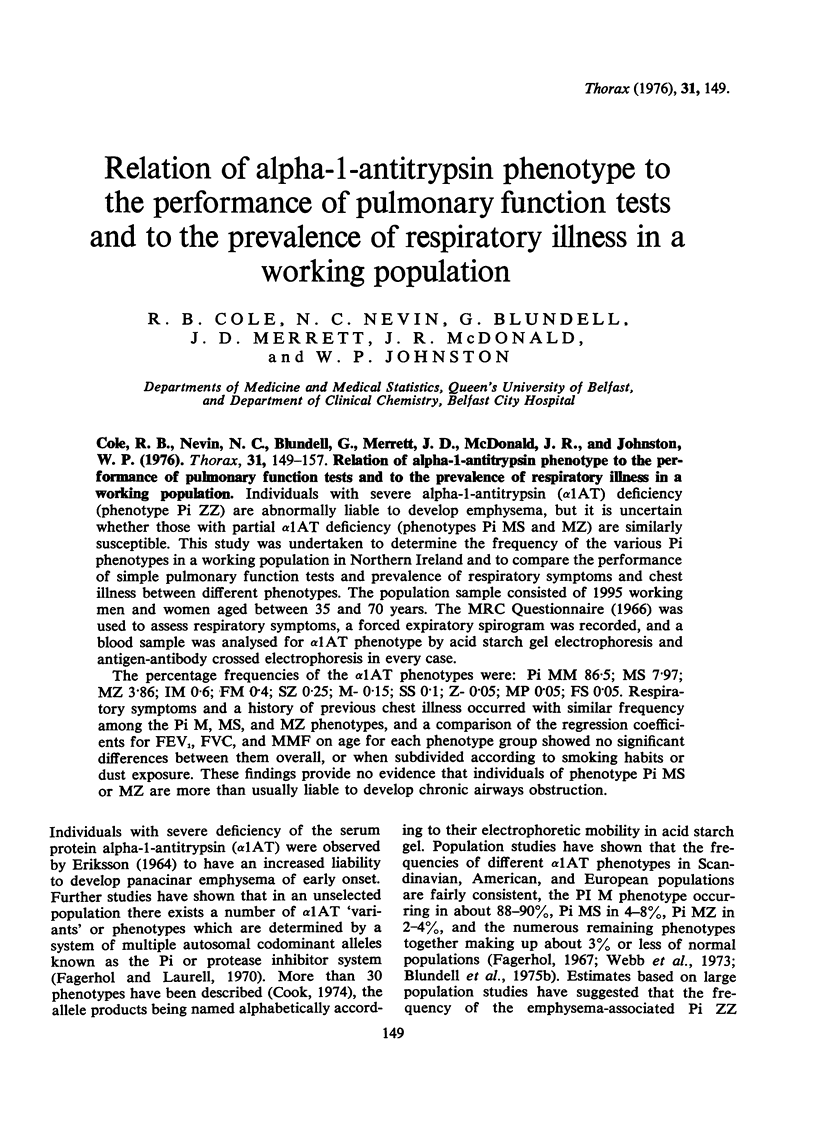
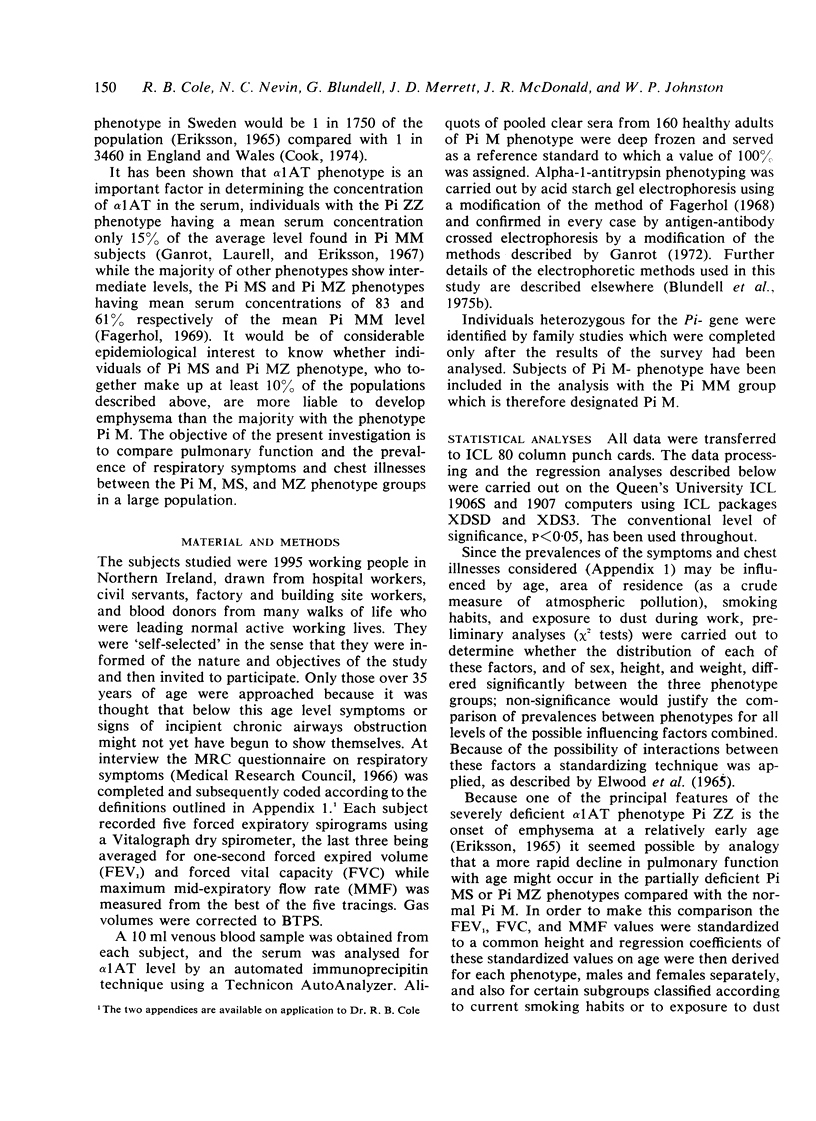
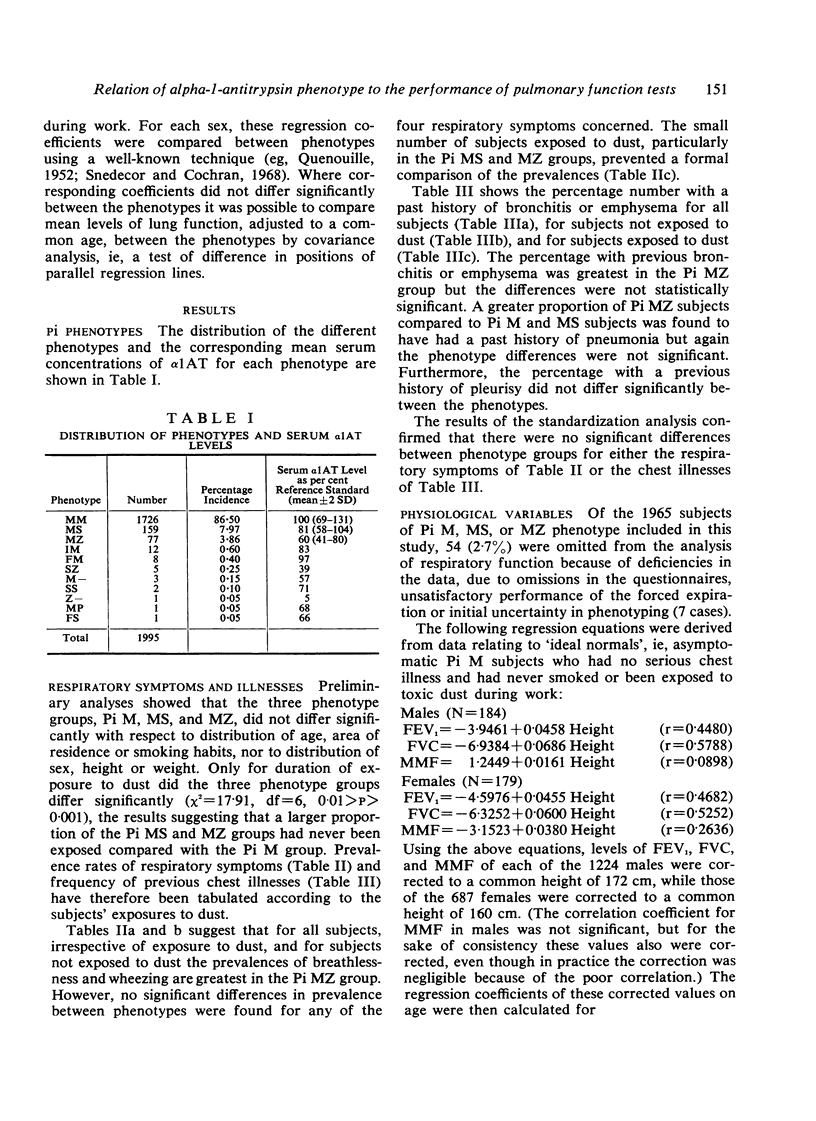
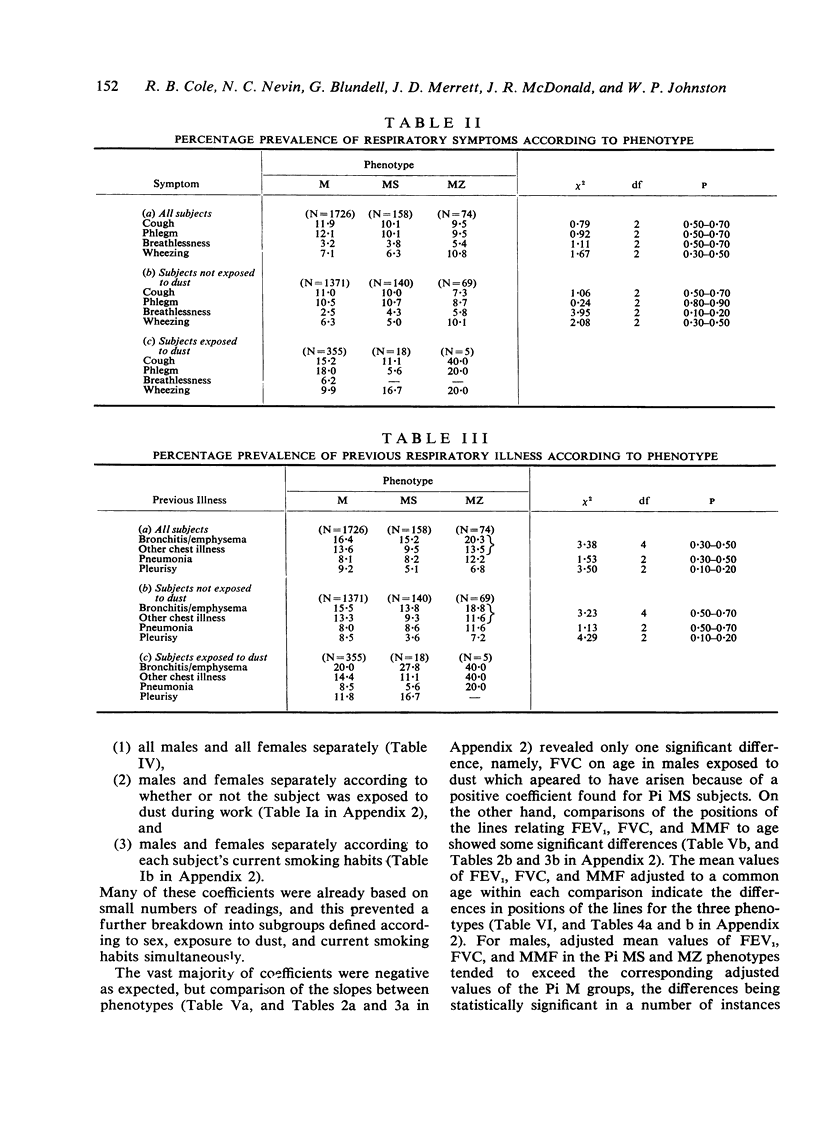
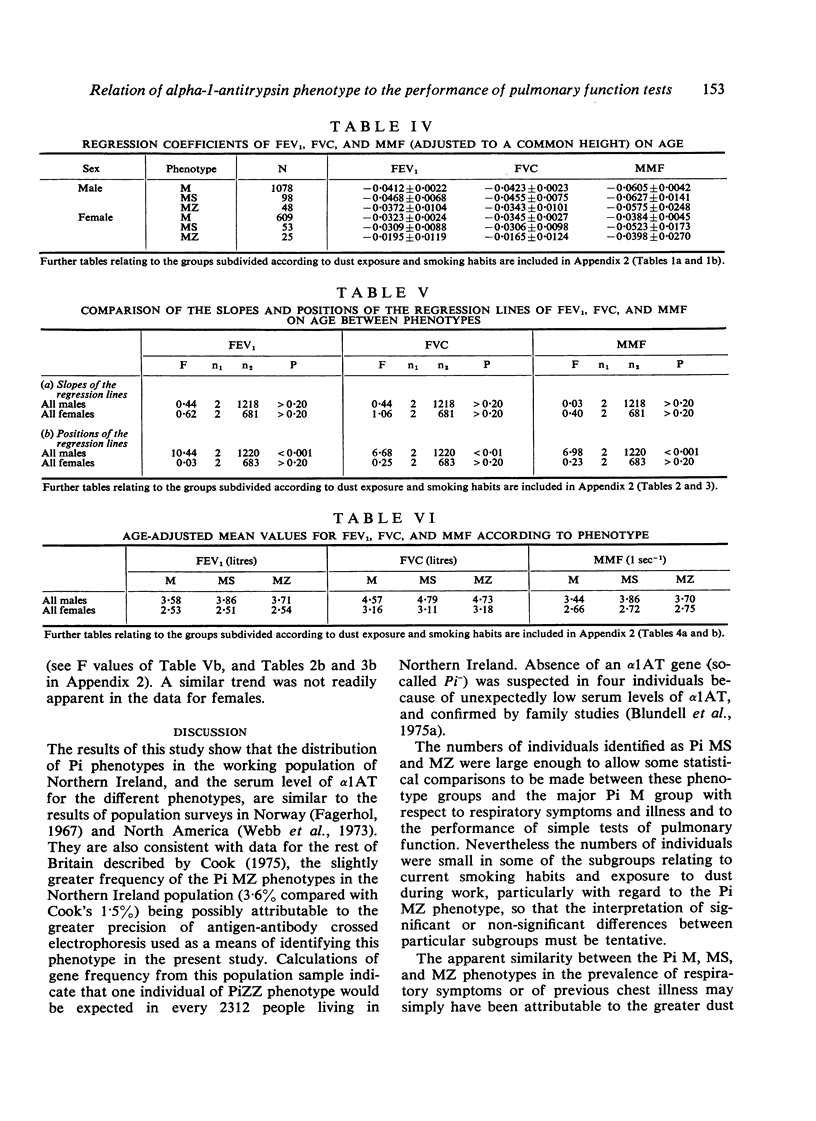
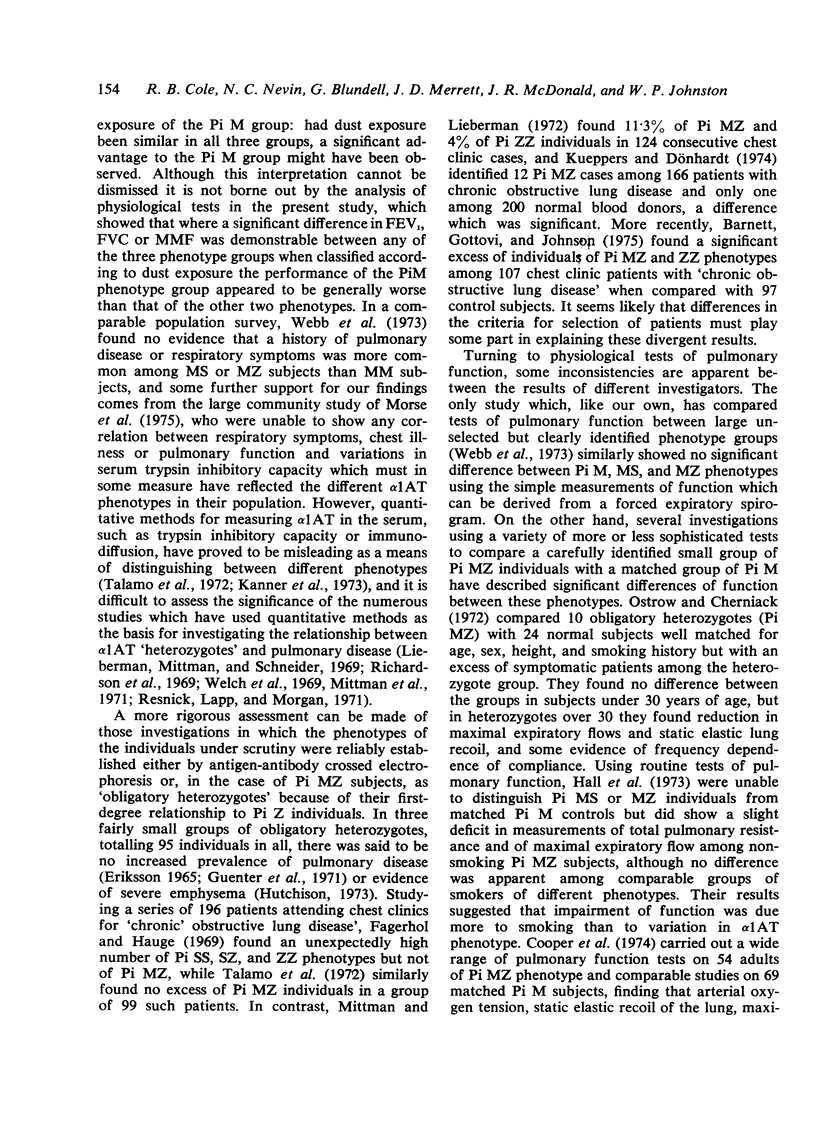
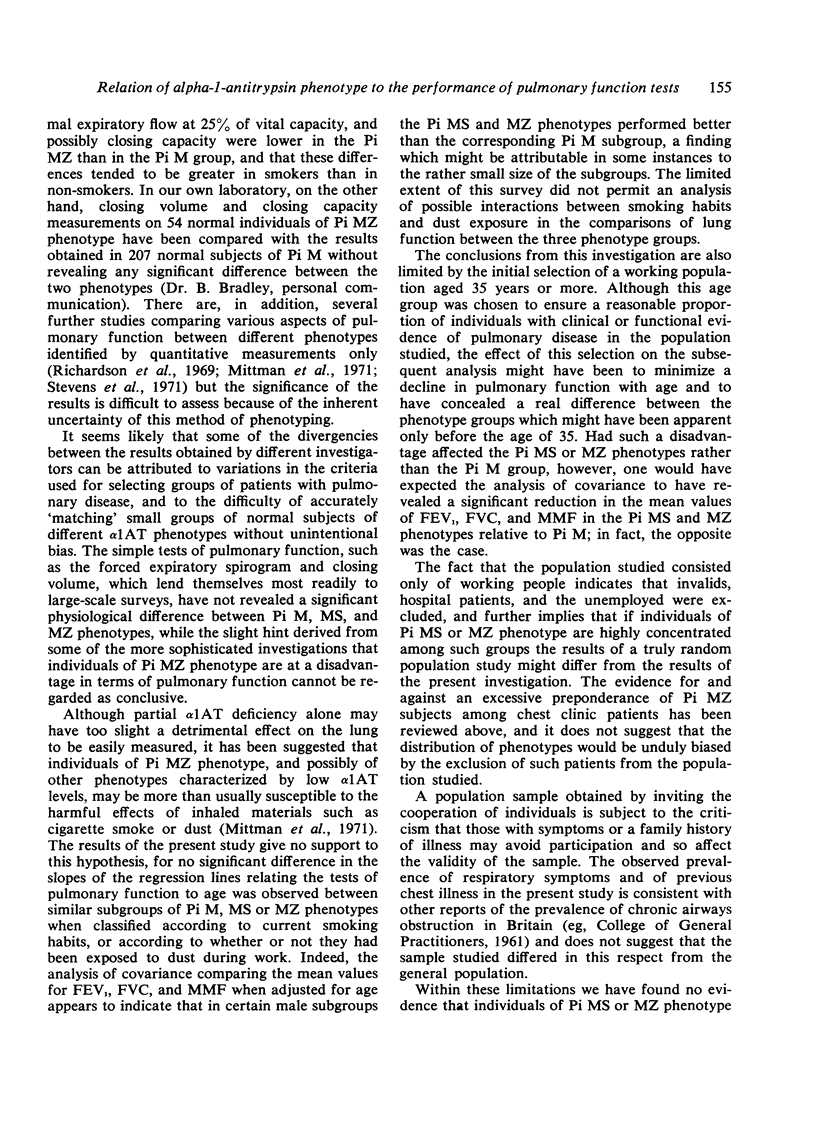

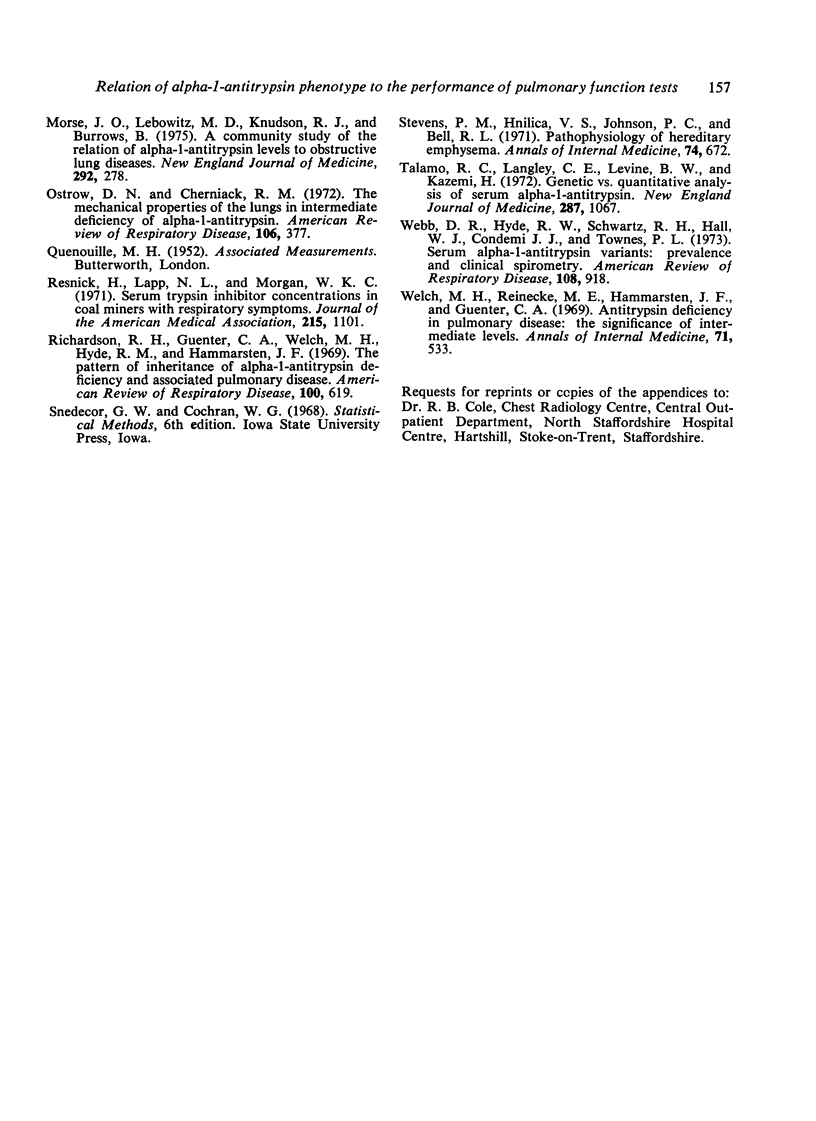
Selected References
These references are in PubMed. This may not be the complete list of references from this article.
- Barnett T. B., Gottovi D., Johnson A. M. Protease inhibitors in chronic obstructive pulmonary disease. Am Rev Respir Dis. 1975 May;111(5):587–593. doi: 10.1164/arrd.1975.111.5.587. [DOI] [PubMed] [Google Scholar]
- Cook P. J. Genetic aspects of the Pi system. Postgrad Med J. 1974 Jun;50(584):362–364. doi: 10.1136/pgmj.50.584.362. [DOI] [PMC free article] [PubMed] [Google Scholar]
- Cooper D. M., Hoeppner V., Cox D., Zamel N., Bryan A. C., Levison H. Lung function in alpha1-antitrypsin heterozygotes (Pi type MZ). Am Rev Respir Dis. 1974 Dec;110(6):708–715. doi: 10.1164/arrd.1974.110.6P1.708. [DOI] [PubMed] [Google Scholar]
- ELWOOD P. C., PEMBERTON J., MERRETT J. D., CAREY G. C., MCAULAY I. R. BYSSINOSIS AND OTHER RESPIRATORY SYMPTOMS IN FLAX WORKERS IN NORTHERN IRELAND. Br J Ind Med. 1965 Jan;22:27–37. doi: 10.1136/oem.22.1.27. [DOI] [PMC free article] [PubMed] [Google Scholar]
- ERIKSSON S. PULMONARY EMPHYSEMA AND ALPHA1-ANTITRYPSIN DEFICIENCY. Acta Med Scand. 1964 Feb;175:197–205. doi: 10.1111/j.0954-6820.1964.tb00567.x. [DOI] [PubMed] [Google Scholar]
- Fagerhol M. K., Hauge H. E. Serum Pi types in patients with pulmonary diseases. Acta Allergol. 1969 May;24(2):107–114. doi: 10.1111/j.1398-9995.1969.tb03760.x. [DOI] [PubMed] [Google Scholar]
- Fagerhol M. K. Serum Pi types in Norwegians. Acta Pathol Microbiol Scand. 1967;70(3):421–428. doi: 10.1111/j.1699-0463.1967.tb01310.x. [DOI] [PubMed] [Google Scholar]
- Ganrot P. O., Laurell C. B., Eriksson S. Obstructive lung disease and trypsin inhibitors in alpha-1-antitrypsin deficiency. Scand J Clin Lab Invest. 1967;19(3):205–208. doi: 10.3109/00365516709090627. [DOI] [PubMed] [Google Scholar]
- Hutchison D. C. Alpha-1-antitrypsin deficiency and pulmonary emphysema: the role of proteolytic enzymes and their inhibitors. Br J Dis Chest. 1973 Jul;67(3):171–196. doi: 10.1016/0007-0971(73)90053-3. [DOI] [PubMed] [Google Scholar]
- Kanner R. E., Klauber M. R., Watanabe S., Renzetti A. D., Jr, Bigler A. Pathologic patterns of chronic obstructive pulmonary diseases in patients with normal and deficient levels of alpha 1 antitrypsin. Am J Med. 1973 Jun;54(6):706–712. doi: 10.1016/0002-9343(73)90056-9. [DOI] [PubMed] [Google Scholar]
- Kueppers F., Dönhardt A. Obstructive lung disease in heterozygotes for alpha-1 antitrypsin deficiency. Ann Intern Med. 1974 Feb;80(2):209–212. doi: 10.7326/0003-4819-80-2-209. [DOI] [PubMed] [Google Scholar]
- Lieberman J. Heterozygous and homozygous alpha-antitrypsin deficiency in patients with pulmonary emphysema. N Engl J Med. 1969 Aug 7;281(6):279–284. doi: 10.1056/NEJM196908072810601. [DOI] [PubMed] [Google Scholar]
- Lieberman J., Mittman C., Schneider A. S. Screening for homozygous and heterozygous alpha 1-antitrypsin deficiency. Protein electrophoresis on cellulose acetate membranes. JAMA. 1969 Dec 15;210(11):2055–2060. [PubMed] [Google Scholar]
- Mittman C., Lieberman J., Marasso F., Miranda A. Smoking and chronic obstructive lung disease in alpha-1-antitrypsin deficiency. Chest. 1971 Sep;60(3):214–221. doi: 10.1378/chest.60.3.214. [DOI] [PubMed] [Google Scholar]
- Morse J. O., Lebowitz M. D., Knudson R. J., Burrows B. A community study of the relation of alpha1-antitrypsin levels to obstructive lung diseases. N Engl J Med. 1975 Feb 6;292(6):278–281. doi: 10.1056/NEJM197502062920602. [DOI] [PubMed] [Google Scholar]
- Ostrow D. N., Cherniack R. M. The mechanical properties of the lungs in intermediate deficiency of 1 -antitrypsin. Am Rev Respir Dis. 1972 Sep;106(3):377–383. doi: 10.1164/arrd.1972.106.3.377. [DOI] [PubMed] [Google Scholar]
- Richardson R. H., Guenter C. A., Welch M. H., Hyde R. M., Hammarsten J. F. The pattern of inheritance of alpha 1 antitrypsin deficiency and associated pulmonary disease. Am Rev Respir Dis. 1969 Nov;100(5):619–625. doi: 10.1164/arrd.1969.100.5.619. [DOI] [PubMed] [Google Scholar]
- Stevens P. M., Hnilica V. S., Johnson P. C., Bell R. L. Pathophysiology of hereditary emphysema. Ann Intern Med. 1971 May;74(5):672–680. doi: 10.7326/0003-4819-74-5-672. [DOI] [PubMed] [Google Scholar]
- Talamo R. C., Langley C. E., Levine B. W., Kazemi H. Genetic vs. quantitative analysis of serum alpha 1 -antitrypsin. N Engl J Med. 1972 Nov 23;287(21):1067–1069. doi: 10.1056/NEJM197211232872104. [DOI] [PubMed] [Google Scholar]
- Webb D. R., Hyde R. W., Schwartz R. H., Hall W. J., Condemi J. J., Townes P. L. Serum alpha 1-antitrypsin variants. Prevalence and clinical spirometry. Am Rev Respir Dis. 1973 Oct;108(4):918–925. doi: 10.1164/arrd.1973.108.4.918. [DOI] [PubMed] [Google Scholar]
- Welch M. H., Reinecke M. E., Hammarsten J. F., Guenter C. A. Antitrypsin deficiency in pulmonary disease: the significance of intermediate levels. Ann Intern Med. 1969 Sep;71(3):533–542. doi: 10.7326/0003-4819-71-3-533. [DOI] [PubMed] [Google Scholar]


